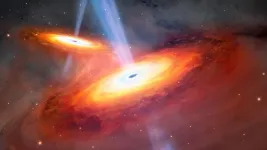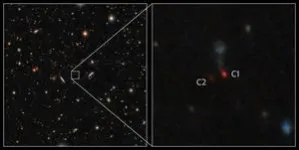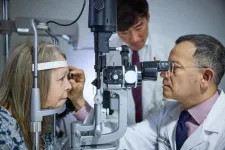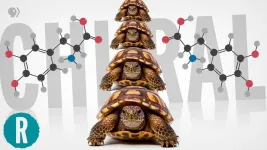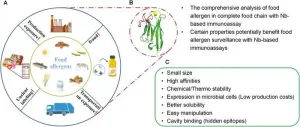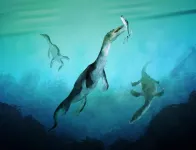(Press-News.org) Since the very first instant after the Big Bang the Universe has been expanding. This means that the early Universe was considerably smaller and early-formed galaxies were more likely to interact and merge. Galaxy mergers fuel the formation of quasars — extremely luminous galactic cores where gas and dust falling into a central supermassive black hole emit enormous amounts of light. So when looking back at the early Universe astronomers would expect to find numerous pairs of quasars in close proximity to each other as their host galaxies undergo mergers. However, they have been surprised to find exactly none — until now.
With the aid of the Gemini North telescope, one half of the International Gemini Observatory, which is supported in part by the U.S. National Science Foundation and operated by NSF NOIRLab, a team of astronomers have discovered a pair of merging quasars seen only 900 million years after the Big Bang. Not only is this the most distant pair of merging quasars ever found, but also the first confirmed pair in the period of the Universe’s history known as Cosmic Dawn.
Cosmic Dawn spanned from about 50 million years to one billion years after the Big Bang. During this period the first stars and galaxies began appearing, filling the dark Universe with light for the first time. The arrival of the first stars and galaxies kicked off a new era in the formation of the cosmos known as the Epoch of Reionization.
The Epoch of Reionization, which took place within Cosmic Dawn, was a period of cosmological transition. Beginning roughly 400 million years after the Big Bang, ultraviolet light from the first stars, galaxies and quasars spread throughout the cosmos, interacting with the intergalactic medium and stripping the Universe’s primordial hydrogen atoms of their electrons in a process known as ionization. The Epoch of Reionization was a critical epoch in the history of the Universe that marked the end of the cosmic dark ages and seeded the large structures we observe in our local Universe today.
To understand the exact role that quasars played during the Epoch of Reionization, astronomers are interested in finding and studying quasars populating this early and distant era. “The statistical properties of quasars in the Epoch of Reionization tell us many things, such as the progress and origin of the reionization, the formation of supermassive black holes during Cosmic Dawn, and the earliest evolution of the quasar host galaxies,” said Yoshiki Matsuoka, an astronomer at Ehime University in Japan and lead author of the paper describing these results, published in the Astrophysical Journal Letters.
About 300 quasars have been discovered in the Epoch of Reionization, but none of them have been found in a pair. That is until Matsuoka and their team were reviewing images taken with the Hyper Suprime-Cam on the Subaru Telescope and a faint patch of red caught their eye. “While screening images of quasar candidates I noticed two similarly and extremely red sources next to each other,” said Matsuoka. “The discovery was purely serendipitous.”
The team was not sure that they were a quasar pair since distant quasar candidates are contaminated by numerous other sources, such as foreground stars and galaxies and the effects of gravitational lensing. To confirm the nature of these objects the team conducted follow-up spectroscopy using the Faint Object Camera and Spectrograph (FOCAS) on the Subaru Telescope and the Gemini Near-Infrared Spectrograph (GNIRS) on Gemini North. The spectra, which break down the emitted light from a source into its component wavelengths, obtained with GNIRS were crucial to characterizing the nature of the quasar pair and their host galaxies.
“What we learned from the GNIRS observations was that the quasars are too faint to detect in near-infrared, even with one of the largest telescopes on the ground,” said Matsuoka. This allowed the team to estimate that a portion of the light detected in the optical wavelength range is not coming from the quasars themselves, but from ongoing star formation taking place in their host galaxies. The team also found that the two black holes are whoppers, each being 100 million times the mass of the Sun. This, coupled with the presence of a bridge of gas stretching between the two quasars, suggests that they and their host galaxies are undergoing a major-scale merger [1].
“The existence of merging quasars in the Epoch of Reionization has been anticipated for a long time. It has now been confirmed for the first time,” said Matsuoka [2].
The Epoch of Reionization connects the earliest formation of cosmic structure to the complex Universe that we observe billions of years later. By studying distant objects from this period astronomers gain valuable insight into the process of reionization and the formation of the first objects in the Universe. More discoveries like this may be on the horizon with NSF–DOE Vera C. Rubin Observatory’s decade-long Legacy Survey of Space and Time (LSST), beginning in 2025, which is poised to detect millions of quasars using its deep imaging capabilities.
Notes
[1] A companion paper accepted for publication in AAS Journals presents further analysis of the quasar pair, the gas bridge between them and their host galaxies using observations taken with the Atacama Large Millimeter/submillimeter Array (ALMA).
[2] There have been candidates, but it is difficult to separate them from possibly gravitationally-lensed images of a single quasar. There are also some candidates for being dual active galactic nuclei embedded in individual Epoch of Reionization galaxies, but these have much lower luminosity (black hole activity) than quasars and are two components within a single galaxy, which are qualitatively different from what is described here.
More information
This research was presented in a paper entitled “Discovery of Merging Twin Quasars at z = 6.05” to appear in the Astrophysical Journal Letters. DOI: 10.3847/2041-8213/ad35c7
The team is composed of Yoshiki Matsuoka (Ehime University, Japan), Takuma Izumi (National Astronomical Observatory of Japan, Tokyo), Masafusa Onoue (Kavli Institute for the Physics and Mathematics of the Universe, Japan), Michael A. Strauss (Princeton University, USA), Kazushi Iwasawa (Universitat de Barcelona Spain), Nobunari Kashikawa (University of Tokyo, Japan), Masayuki Akiyama (Tohoku University, Japan), Kentaro Aoki (Subaru Telescope, National Astronomical Observatory of Japan, USA), Junya Arita (University of Tokyo, Japan), Masatoshi Imanishi (National Astronomical Observatory of Japan, Graduate University for Advanced Studies [SOKENDAI], Japan), Rikako Ishimoto (University of Tokyo, Japan), Toshihiro Kawaguchi (Onomichi City University, Japan), Kotaro Kohno (University of Tokyo, Japan), Chien-Hsiu Lee (W. M. Keck Observatory, USA), Tohru Nagao (Ehime University, Japan), John D. Silverman (Kavli Institute for the Physics and Mathematics of the Universe, Japan), and Yoshiki Toba (Ehime University, Japan, National Astronomical Observatory of Japan, Tokyo, Academia Sinica Institute of Astronomy and Astrophysics, Taiwan)
NSF NOIRLab (U.S. National Science Foundation National Optical-Infrared Astronomy Research Laboratory), the U.S. center for ground-based optical-infrared astronomy, operates the International Gemini Observatory (a facility of NSF, NRC–Canada, ANID–Chile, MCTIC–Brazil, MINCyT–Argentina, and KASI–Republic of Korea), Kitt Peak National Observatory (KPNO), Cerro Tololo Inter-American Observatory (CTIO), the Community Science and Data Center (CSDC), and Vera C. Rubin Observatory (operated in cooperation with the Department of Energy’s SLAC National Accelerator Laboratory). It is managed by the Association of Universities for Research in Astronomy (AURA) under a cooperative agreement with NSF and is headquartered in Tucson, Arizona. The astronomical community is honored to have the opportunity to conduct astronomical research on I’oligam Du’ag (Kitt Peak) in Arizona, on Maunakea in Hawai‘i, and on Cerro Tololo and Cerro Pachón in Chile. We recognize and acknowledge the very significant cultural role and reverence that these sites have to the Tohono O’odham Nation, to the Native Hawaiian community, and to the local communities in Chile, respectively.
END
International Gemini Observatory and Subaru combine forces to discover first ever pair of merging quasars at cosmic dawn
Observations with the Gemini North telescope aid in the discovery of the most distant pair of merging quasars, seen only 900 million years after the Big Bang
2024-06-17
ELSE PRESS RELEASES FROM THIS DATE:
Repurposed drug may help stabilize vision in rare disease
2024-06-17
Roughly 50 families scattered across the world share ultra-rare variants in a particular gene. Silent for years, the inherited mutations make themselves known when patients reach the fourth decade of life. Changes in vision start a cascade of symptoms. Five to 20 years later, the illness is fatal.
Researchers at Washington University School of Medicine in St. Louis have dedicated many years to understanding the rare condition known as retinal vasculopathy with cerebral leukoencephalopathy and systemic manifestations, or RVCL-S, with the aim of developing a treatment ...
Face screening tool detects stroke in seconds
2024-06-17
A new smartphone face-screening tool could help paramedics to identify stroke in seconds – much sooner and more accurately than is possible with current technologies.
Strokes, which affect millions of people globally, occur when the blood supply to part of the brain is interrupted or reduced, which prevent brain tissue from getting oxygen and nutrients. A few minutes of delay can result in permanent damage to the brain cells.
A team of biomedical engineers at RMIT University developed the AI capabilities behind the software technology and has published their results ...
Making this Parkinson's drug is just turtles all the way down (video)
2024-06-17
WASHINGTON, June 17, 2024 — L-DOPA is the best drug we have for Parkinson’s disease, but its molecular mirror image, D-DOPA, causes dangerous side effects. Making L-DOPA without also making D-DOPA is surprisingly hard and requires a specific kind of molecule to pull off. But that specific molecule must be made from a different and equally specific molecule. In this video, our host, George Zaidan, explains how one of the winners of the 2001 Nobel Prize in Chemistry pulled it off, and why "chiral synthesis," as it's called, is really just turtles all the way down. https://youtu.be/_cb09XB07LQ?si=BuMEI5fOuHmuQlkZ
Reactions is a video series ...
Camelid nanobodies: Transforming food allergen analysis
2024-06-17
Recent advancements show nanobodies from camelid antibodies excel in food allergen detection with superior stability, specificity, and cost-effectiveness. This innovative approach aims to improve accuracy and efficiency, crucial for preventing severe allergic reactions. The study highlights nanobodies' potential in reliable immunoassays, addressing rising food allergies and enhancing safety measures.
Food allergies pose significant health risks, affecting millions worldwide, with the prevalence rising over the past decades. Traditional detection methods, such as monoclonal and polyclonal antibodies, are often costly, labor-intensive, and prone to cross-reactions. The need for ...
Federal study examines care following nonfatal overdose among Medicare beneficiaries; identifies effective interventions and gaps in care
2024-06-17
Researchers from the Substance Abuse and Mental Health Services Administration (SAMHSA), the National Institutes of Health’s (NIH) National Institute on Drug Abuse (NIDA), Centers for Medicare & Medicaid Services (CMS), and the Centers for Disease Control and Prevention (CDC) found that among a cohort of 137,000 Medicare beneficiaries who experienced a nonfatal overdose in 2020, almost 24,000 (17.4%) experienced a subsequent nonfatal overdose, and about 1,300 (1%) died from overdose in the following year. Results were published today in JAMA Internal Medicine, identifying both effective interventions and significant gaps in care.
“People who have experienced ...
Maternal inheritance of Alzheimer’s disease tied to increased risk of developing disease
2024-06-17
KEY TAKEAWAYS
Mass General Brigham researchers analyzed 4,400 cognitively unimpaired adults with amyloid imaging, finding increased amyloid in those who reported that their mothers had symptoms of Alzheimer’s disease (AD).
Increased amyloid, a biomarker of AD, was also found in those with a history of the disease on both sides of their family and in those whose fathers had an early onset of symptoms.
The study suggests that a person’s maternal versus paternal family history could ...
Epidemiologic features of recovery from SARS-CoV-2 infection
2024-06-17
About The Study: More than 1 in 5 adults did not recover within 3 months of SARS-CoV-2 infection in this cohort study. Recovery within 3 months was less likely in women and those with preexisting cardiovascular disease and more likely in those with COVID-19 vaccination or infection during the Omicron variant wave.
Corresponding Author: To contact the corresponding author, Elizabeth C. Oelsner, M.D., M.P.H., email eco7@cumc.columbia.edu.
To access the embargoed study: Visit our For The Media website at this link https://media.jamanetwork.com/
(doi:10.1001/jamanetworkopen.2024.17440)
Editor’s Note: Please see the article for additional information, ...
Electronic cigarettes vs varenicline for smoking cessation in adults
2024-06-17
About The Study: This randomized clinical trial found that varenicline and nicotine-containing electronic cigarettes were both effective in helping individuals in quitting smoking conventional cigarettes for up to 6 months.
Corresponding Author: To contact the corresponding author, Anna Tuisku, Ph.D., email anna.tuisku@lapha.fi.
To access the embargoed study: Visit our For The Media website at this link https://media.jamanetwork.com/
(doi:10.1001/jamainternmed.2024.1822)
Editor’s Note: Please see the article ...
Risk factors for long COVID revealed
2024-06-17
NEW YORK, NY (June 14, 2024)--Early in the pandemic, many people who had SARS-Cov-2 infection or COVID-19 began to report that they couldn’t shake off their symptoms even after a month or more—unusually long for a viral infection of the upper respiratory tract—or developed new, persistent symptoms soon after the infection cleared.
Although it’s still not clear what causes post-COVID-19 conditions or “long COVID” (symptoms and conditions that develop, linger, or reoccur weeks or months after SARS-CoV-2 infection), a new study by researchers at Columbia University Vagelos College ...
Ancient polar sea reptile fossil is oldest ever found in Southern Hemisphere
2024-06-17
An international team of scientists has identified the oldest fossil of a sea-going reptile from the Southern Hemisphere – a nothosaur vertebra found on New Zealand’s South Island. 246 million years ago, at the beginning of the Age of Dinosaurs, New Zealand was located on the southern polar coast of a vast super-ocean called Panthalassa.
Reptiles first invaded the seas after a catastrophic mass extinction that devastated marine ecosystems and paved the way for the dawn of the Age of Dinosaurs almost 252 million years ago. Evidence for this evolutionary milestone has only been discovered in a few places around the world: on the Arctic island of Spitsbergen, northwestern North ...
LAST 30 PRESS RELEASES:
Scalable and healable gradient textiles for multi‑scenario radiative cooling via bicomponent blow spinning
Research shows informed traders never let a good climate crisis go to waste
Intelligent XGBoost framework enhances asphalt pavement skid resistance assessment
Dual-function biomaterials for postoperative osteosarcoma: Tumor suppression and bone regeneration
New framework reveals where transport emissions concentrate in Singapore
NTP-enhanced lattice oxygen activation in Ce-Co catalysts for low-temperature soot combustion
Synergistic interface engineering in Cu-Zn-Ce catalysts for efficient CO2 hydrogenation to methanol
COVID-19 leaves a lasting mark on the human brain
Scientists use ultrasound to soften and treat cancer tumors without damaging healthy tissue
Community swimming program for Black youth boosts skills, sense of belonging, study finds
Specific depressive symptoms in midlife linked to increased dementia risk
An ‘illuminating’ design sheds light on cholesterol
Who is more likely to get long COVID?
Study showcases resilience and rapid growth of “living rocks”
Naval Research Lab diver earns Office of Naval Research 2025 Sailor of the Year
New Mayo-led study establishes practical definition for rapidly progressive dementia
Fossil fuel industry’s “climate false solutions” reinforce its power and aggravate environmental injustice
Researchers reveal bias in a widely used measure of algorithm performance
Alcohol causes cancer. A study from IOCB Prague confirms damage to DNA and shows how cells defend against it
Hidden viruses in wastewater treatment may shape public health risks, study finds
Unlock the power of nature: how biomass can transform climate mitigation
Biochar reshapes hidden soil microbes that capture carbon dioxide in farmland
Reducing saturated fat intake shows mortality benefit, but only in high-risk individuals
Manta rays create mobile ecosystems, study finds
Study: Mixed results in using lipoic acid to treat progressive multiple sclerosis
Norbert Holtkamp appointed director of Fermi National Accelerator Laboratory
New agentic AI platform accelerates advanced optics design
Biologists discover neurons use physical signals — not electricity — to stabilize communication
Researchers discover that a hormone can access the brain by hitchhiking
University of Oklahoma researcher awarded funding to pursue AI-powered material design
[Press-News.org] International Gemini Observatory and Subaru combine forces to discover first ever pair of merging quasars at cosmic dawnObservations with the Gemini North telescope aid in the discovery of the most distant pair of merging quasars, seen only 900 million years after the Big Bang
